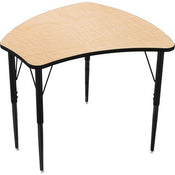
Collaborative Learning Desk Buying Guide
Collaborative learning desks are a real ace up the sleeve for an innovative teaching space where your students can flourish. Here is a complete guide to buying collaborative learning desks.
School Outlet’s Tips
-

Portability and Flexibility
Choose AV equipment that offers portability and flexibility, allowing for easy setup and movement between different classrooms or venues. Consider options like portable projectors and wireless sound systems for added convenience.
-

Size and Shape
Ensure desks are the right size and shape to fit your classroom, allowing students to face each other comfortably and collaborate while providing enough space to move around.
-

Durability and Maintenance
Select desks made of robust, durable materials for frequent rearrangement. Ensure the structure and surface are sturdy and easy to clean and maintain.
-

Technical Support
Opt for AV equipment from manufacturers that provide robust technical support. Reliable customer service and accessible troubleshooting resources can save time and prevent disruptions during use.
-

Accessibility and Ergonomics
Ensure sinks are accessible and ergonomic for all users, including students and teachers. Consider adjustable height options and easy-to-reach faucets to promote comfort and usability in the classroom.
-

Storage and Accessibility
Look for desks with built-in storage like book boxes or shelves under the desktop to keep learning materials organized and easily accessible.
Collaborative Learning Desk Styles
-

MoorecoEconomy Desk
The Mooreco Economy Desks can be arranged in multiple configurations. They have a snap-on-leg system that makes the desk easy to assemble. The desks are height-adjustable as well. You can add accessories like wired book boxes and backpack hooks.
-

Virco Molecule Series Desks
They have a thick tubular steel frame and a thick particleboard core with a high-pressure laminate top. They have nylon-base swivel guides or optional casters for easy mobility. You can equip the desk with a book box, book rack, or backpack hanger.
-

Virco ZBOOM Desks
The unique boomerang shape of the Virco ZBOOM Desks offers endless arrangement options. You can get these desks on multiple work surfaces and adjustable height options.
-

Virco ZHEX Desks
Virco ZHEX Desks allow up to six desks that combine to form a seven-foot octagon. They feature a robust tubular steel construction and have adjustable glides.
-

Virco ZOCT Desks
The octagon shape of the Virco ZOCT Desks has a large 21" x 31" top made of hard plastic. The tubular frame is height-adjustable to accommodate students of different age groups.
Frequently Asked Questions
-
The standard recommendation for space per student at a collaborative desk is around 30 inches of desktop space per student. Arrange the desk to provide ample workspace while allowing students to see and interact with one another easily. Leave sufficient aisle space between the desks so that you can monitor effectively.
-
Most collaborative desks offer storage solutions like open book boxes, shelves underneath the desktop surface, or backpack hooks. They allow easy access to essentials like stationary materials during activities. These storage options also reduce clutter. The storage area is constructed using metal, wood, or plastics. Some desks have enclosed lift-lid storage compartments as well.
-
The most typical seating arrangement with collaborative learning desks is a circular pod of 4 or more desks and chairs facing inward to optimize face-to-face discussion. However, desks can also be arranged in semi-circles, rectangles, or other geometric shapes to suit different activities. Reconfigure the setup to suit your teaching methodology best.
-
Steel frames with laminated or heavy-duty plastic work surfaces are the best materials. Look for desks with robust tubular frames and sturdy legs that distribute weight evenly. When desks are moved around, it prevents legs from wobbling or bending out of alignment. High-pressure laminate, durable plastic or wood composite surfaces provide desktops with stain, scratch, and impact resistance.














